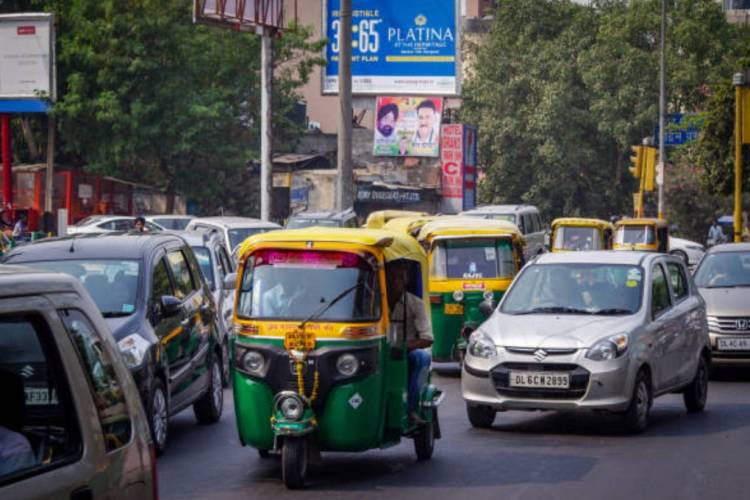
CAFE-3 norms: The automobile industry is once again at odds with the government over environmental regulation—this time over the proposed Corporate Average Fuel Efficiency Phase 3 norms, scheduled for implementation in April 2027. At the centre of the debate is Maruti Suzuki Chairman RC Bhargava, who argues that a single emission norm for all vehicle categories unfairly penalises small cars, despite their superior environmental and resource efficiency. While most industry players back a unified norm, Bhargava and a section within the government advocate separate standards for smaller vehicles.
CAFE norms are designed to reduce vehicular emissions by mandating that manufacturers meet average fleet-wide carbon dioxide targets, adjusted for vehicle weight and sales volume. Heavier vehicles are allowed to emit more CO₂ per kilometre, whereas lighter vehicles—typically smaller and more efficient—must meet stricter thresholds.
READ | BRICS economic goals clash with India’s Quad strategy
This formula results in a paradox. While larger sport utility vehicles get more leeway, smaller vehicles, even those that already emit less, are expected to further improve. For companies with a portfolio skewed towards compact cars, this translates into disproportionate compliance burdens.
Imported framework, local challenges
India’s adoption of CAFE norms, modelled on European regulatory frameworks, ignores key differences in local market dynamics. Europe’s shrinking small car market contrasts with India’s continuing dependence on affordable, compact vehicles for mass mobility. In India, small cars consume less fuel, use fewer raw materials, and emit less CO₂ per passenger kilometre—benefits that go unrewarded under the current norm structure.
Bhargava and others have called for differentiated norms that would recognise these environmental and socioeconomic efficiencies, rather than penalise them under a uniform regime.
The vanishing entry level car
There is growing unease within the industry that continued regulatory tightening, without nuance, may accelerate the decline of the small car segment. Hatchbacks and sedans have already become unaffordable for many entry-level buyers. If regulatory pressure continues without relief, carmakers may find little commercial incentive to stay in the small car business, pivoting instead to SUVs and multi-purpose vehicles.
This shift is not without consequence. India has one of the lowest rates of car ownership globally—about 10% of households own a car. Most Indians still rely on two-wheelers, and for many, a small car represents the first—and perhaps only—chance of four-wheeled mobility. Unlike in Europe or the US, India’s middle class depends heavily on economical vehicles.
The erosion of this segment could shut out millions from personal mobility, a reality at odds with aspirations of inclusive growth.
The small car buyer now faces a triple blow: Corporate Average Fuel Efficiency norms, stricter Bharat Stage emission standards, and the vehicle scrapping policy. All three, aimed at environmental improvement, are inadvertently raising costs and pushing new car ownership out of reach for middle-class families.
Industry insiders point out that while the objectives—lower emissions and cleaner air—are laudable, implementation needs to be tempered with realism. The risk is not just the decline of a vehicle category, but the exclusion of a socio-economic class from a key symbol of progress.
A shifting consensus
Despite years of consultations, the regulatory landscape remains unsettled. In December 2024, the government submitted a consensus draft on CAFÉ-3 after industry-wide feedback. But that position is now under reconsideration, after a major manufacturer requested concessions for vehicles under 1,000 kg.
Such recalibration, though well-intentioned, could tilt the competitive landscape. If exemptions are granted selectively, it could impose disproportionate costs on companies focused on heavier vehicles while creating unintended loopholes for others.
Mathematically, granting leniency to small cars raises the industry’s average permissible CO₂ emissions. That would effectively dilute the stringency of CAFÉ-3 and allow some firms to retain targets close to the older, less demanding CAFE-2 levels—inviting charges of unfair advantage.
What’s driving small car decline
To be fair, regulatory costs are not the only reason for the fall in small car sales. Consumer preferences are shifting. Buyers today value space, higher driving position, and digital features—all more readily available in compact SUVs than in traditional hatchbacks. But rising prices due to regulatory burdens have undoubtedly accelerated the decline.
There remains, however, significant support for protecting small cars. Not just from industry groups, but also from researchers and analysts.
Rethinking the regulatory approach
A recent study by Nomura Research recommends that India reform its CAFE norms to align more closely with global best practices. Major auto markets such as the US, EU, China, Japan, and South Korea follow flexible frameworks that recognise the role of small, efficient vehicles. In contrast, India’s linear structure lacks this nuance. These countries adopt credit-based systems, technology multipliers, or dedicated protection for light vehicles—tools that balance environmental goals with market realities.
India could adapt such mechanisms to offer regulatory relief to fuel-efficient small cars without diluting its broader climate targets. After all, incentivising smaller vehicles also serves national energy goals, given India’s 85% reliance on imported oil.
This is no longer just an environmental debate—it is a question of socioeconomic access. As the government presses ahead with its green agenda, it must guard against creating a car market that serves only the affluent.
At stake is not only the fate of India’s small car segment but also the mobility dreams of millions. A nation aspiring for broad-based prosperity must ensure that clean transport does not become a luxury. The regulatory compass needs adjustment—so that ambition and inclusion can drive side by side.
